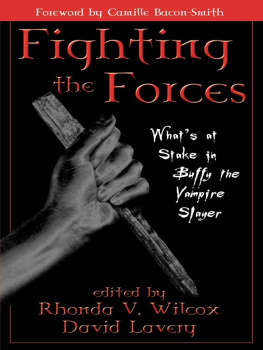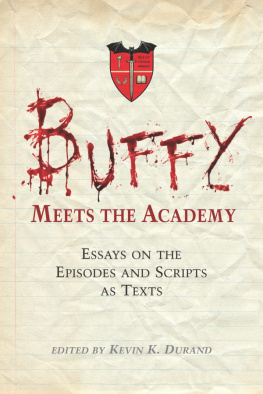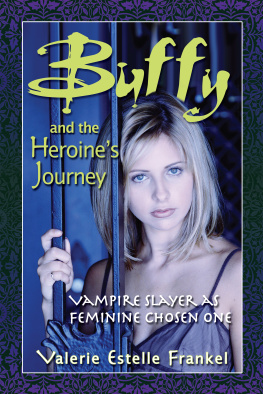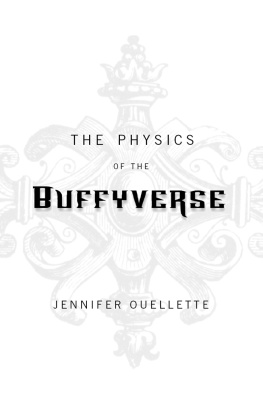
The Aesthetics of Culture in Buffy the Vampire Slayer
Matthew Pateman

McFarland & Company, Inc., Publishers
Jefferson, North Carolina
LIBRARY OF CONGRESS CATALOGUING DATA ARE AVAILABLE
BRITISH LIBRARY CATALOGUING DATA ARE AVAILABLE
e-ISBN: 978-1-4766-0612-5
2006 Matthew Pateman. All rights reserved
No part of this book may be reproduced or transmitted in any form or by any means, electronic or mechanical, including photocopying or recording, or by any information storage and retrieval system, without permission in writing from the publisher.
Cover photograph: 2006 Ingram Publishing
McFarland & Company, Inc., Publishers
Box 611, Jefferson, North Carolina 28640
www.mcfarlandpub.com
Acknowledgments
First and foremost, thank you to Joss Whedon and the whole Buffy team, for giving us seven wonderful seasons about which to ponder and write. Once Buffy became established as the phenomenon it is, scholars such as David Lavery, Rhonda Wilcox, Roz Kaveney, and Sue Turnbull provided an academic environment in which studies could flourish, so thanks are due to them and to the many others who have written or spoken so compellingly on the show over the last few years.
The writing of the current book took place in Scarborough, United Kingdom, and Cleveland, Ohio. For making my stay at John Carroll University in Cleveland so enjoyable, and productive, thanks are due to the students who were such a joy and to members of the English Department, especially Chris Roarke, Amy Roarke, Anna Hocevar, Tom Pace, Peter Kvidera, Francis Ryan, Phil Metres and Steven Heyward. For Buffy nights and great conversations, thank you to Melissa Milavec, Courtney Tunmore and Sharon Kaye. Special thanks to George Bilgere and Jody Rufus.
Closer to home, thank you to Charles Mundye and Anna Fitzer, for coping with my distractions over the last months, and to Martin Arnold and Maria Arnold for consistent splendor. Everybody needs a gang, so to the Scarborough Scoobies who fueled enthusiasm and sparked debatePete Massey, Rach Massey, Lee Taylor, and Kate Marriottthank you. And for nights hunched over the computer screen with red wine and friendship, my thanks to Kerry Ward and Claire Matson.
Untold gratitude to my parents and to all of my family for their continued support and love. And, for the house that appeared around me, the as-if-by-magic food, the love and, above all, the patience, while I was busy doing this, thank you, Kelly, my very own Power That Be.
A Note on the Text
Buffy the Vampire Slayer as a title is usually shortened to Buffy, except where a particular point about the title is being made, or confusion with the character, Buffy, may occur.
Episode titles are given in full, followed by their season and episode number, unless an episode is being referenced many times on a single page, in which case the season and episode numbers only will be given. For example, Welcome to the Hellmouth (1.1) would be referenced simply as (1.1) if mentioned again very soon after the initial reference.
Episodes from Angel will also be given full titles with season and episode numbers prefixed by AtS to signify their provenance. For example, Spin the Bottle (AtS 4.6).
Slayage: The Online International Journal of Buffy Studies is referred to as Slayage throughout.
Introduction
What kind of name is Buffy?
Rarely has a television series had such a seemingly silly-sounding name as Buffy the Vampire Slayer. Whether taken individually or in juxtaposition, the two main phrases that make up the name invite, it would appear, derision. Buffy conjures images of the inconsequential, blonde, fluffy, intellectually insipid, mall-worshiping fashion junky who is the quintessential postmodern American middle-class teen. Vampire slayer is little better. Locating itself in a historical halfway house between modernitys revisiting of the early modern in tales of the vampire, and a premodern pseudo-mythic world of dragons and knights with the notion of the slayer, the phrase sounds like cultural eclecticism run mad. Placed next to the name Buffy, this hybrid title, with all its apparent disregard for history, offers a cartoon aesthetic and is just another example of disposable pop: a vacuous product for a diminished culture.
By the time the high school girl with the even more preposterous nameAphrodisiaasks her friend, What kind of name is Buffy? in the first episode of the first season, Welcome to the Hellmouth (1.1), any notion of the vacuous has been dispelled. As we will have seen in the opening few minutes of this episode, and as the remaining 143 will go on to enforce, Buffy is one of the most important contributions to the presentation and analysis of contemporary American culture, and it undertakes this with a televisual aesthetic virtuosity that is unrivaled. So why the silly name?
In part, the answer to that question is simple. It offers itself up as part of the very critique of culture that the show is undertaking; it revels in its own ostensible shallowness in order to demonstrate that popular culture, however frivolous it may seem, is worthy of more serious attention, but that only those who are willing to forego deeply embedded hierarchies of taste will be welcome on the ride. In what amounts to an inversion of Umberto Ecos famous rebuke to those who found the opening to his fabulous novel The Name of the Rose too difficult, and to whom he replied that only those willing to endure the initial difficulty were welcome as fellow travelers on Adsos and Williams journey,
However, this itself would be little more than a pleasing but slight game if that is all there was to it. The title of the show is more than simply a celebration of popular culture: it is a precise and extraordinarily careful introduction to the shows aims both in terms of its aesthetic practice and its cultural claims. The eclecticism mentioned above, that appears to be an effacement of history and a recapitulation of the postmodern delight in depthlessness, is very far from this. It is, of course, possible to argue, as Jean-Franois Lyotard does, that:
Eclecticism is the degree zero of contemporary general culture: one listens to reggae, watches a western, eats McDonalds food for lunch and local cuisine for dinner, wears Paris perfume in Tokyo and retro clothes in Hong Kong; knowledge is a matter for TV games. It is easy to find a public for eclectic works.
However, eclecticism need not be so disturbing. The great champion of the avant-garde, Lyotard, at this moment, mistook the dangers of a general cultural phenomenon as translatable to particular manifestations. When general culture is also dominated by niche markets that require clearly defined objects of consumption that conform to preestablished modes of expression (another aspect of contemporary culture that, rightly, irked Lyotard), then the eclectic-minded (or genre-busting) product is a welcome and necessary antidote.) by producing something new that pays homage to both. This is what Buffy does, and what its title, teasingly, proposes. But even this, exciting and desired though it may be, is not enough.
A generic amalgam that still flattened out history, as the title may be thought to do, would be aesthetically pleasing but culturally only a symptom of a more pervasive dehistoricization. The generic fusion of high school drama and gothic horror (to mention only the two most prominent of the staggering number of genres present in the show) supplies the aesthetic corollary of this cultural undertaking.
Next page







